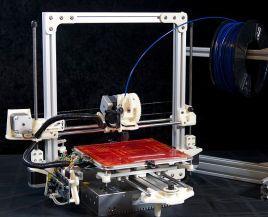Counterfeit could become an increasing problem as 3D printing technology takes off
In 1968, the celebrated US pop artist Andy Warhol showed a collection of his works at the Moderna Museet gallery in Stockholm, Sweden. It was his first international retrospective exhibition, but that is not why the event is remembered. Instead it is 11 words Warhol wrote in the exhibition catalogue that continue to resonate: “In the future, everybody will be world famous for 15 minutes.”
Artistic pretension was nothing new in the 1960s, nor was the way in which people pretended to ‘understand’ what Warhol meant by interpreting the statement in various ways. Warhol was a master of the absurd. Most likely he was simply being provocative and he could have had little idea of the enduring quality of his words when he wrote them. Over the years, in interviews, Warhol offered a range of rationales for his statement, although often this was because he had become bored with the question.
Most commonly, the phrase has been applied by the media to describe the disposable nature of modern celebrity, where fame is fleeting and those on whom it is bestowed somehow become instantly forgettable. Nowhere is this more apparent than with reality television that has spawned myriad vacuous stars who shine briefly before their light is mercifully snuffed out.
Whether Warhol was attempting to predict the way in which society would develop is debatable. However, he was a mass producer of art using a variety of media - that is why his New York studio was called “The Factory” - and an educated guess might suggest he would find certain technological changes seen today inspirational. He would surely have found artistic potential in social media, 3D printers and devices that record our every move and let individuals star in a never-ending film of their lives.
The much-anticipated Google Glass wearable technology is now reality and being tested by some of the company’s employees and members of the media. Wearers see the world through what has been dubbed “Google-vision” with images appearing on a screen attached to high-tech spectacles. Google Glass responds to voice commands in the same way as a smartphone - only the user is wearing it. Ask it to take a photograph and a tiny camera built into the frame will capture what the wearer can see.
While still in development it is not inconceivable that in a few short years these devices will not only be ubiquitous but also considerably more sophisticated. Already there are concerns over privacy implications. Users of the technology might be expected to ask permission when recording images - particularly of other people - but will they do so in reality? If wearers took this approach walking down a busy street they would likely remain rooted to the pavement for the rest of their lives. The potential for business security being compromised appears huge. Casino operators will not be the only ones calling for a ban.
If manufacturers can make their products more easily and cheaply, so can competitors and counterfeiters
A wearable camera device created by Swedish company Memoto raises similar issues. The size of a badge, Memoto takes pictures at 30-second intervals so individuals can document, record and share their every experience. While the product will doubtless attract the vain and those with an over-blown sense of their own importance, a world where everyone can wear a camera that records continuously fills many with alarm.
In another area of concern, the hysteria surrounding the manufacture of guns using 3D printers has highlighted a problem but also masked the real issues surrounding the equipment.
Printing in 3D could mean the end of supply chain troubles for some companies by allowing products to be made onsite. Resources permitting, it is likely that businesses will at least consider their use as part of a back-up plan should other supply options fail.
But what about the reverse side? If manufacturers can make their products more easily and cheaply, so can competitors and counterfeiters. Hackers are increasingly targeting company technology. What could stop them posting secret company plans on the internet and allowing free access for millions to reproduce the products at home?
Artists such as Warhol have their work copied and reproduced thousands of times every day. While The Andy Warhol Foundation for the Visual Arts takes a dim view of such practice, others, including the street artist Banksy, are more democratic and allow some images to be downloaded free.
Will business respond the same way and offer open access to their products for 3D printing? Some might see a strategic advantage to this, but for the majority it represents a threat that could ultimately destroy them. Perhaps in as little as 15 minutes.


















No comments yet